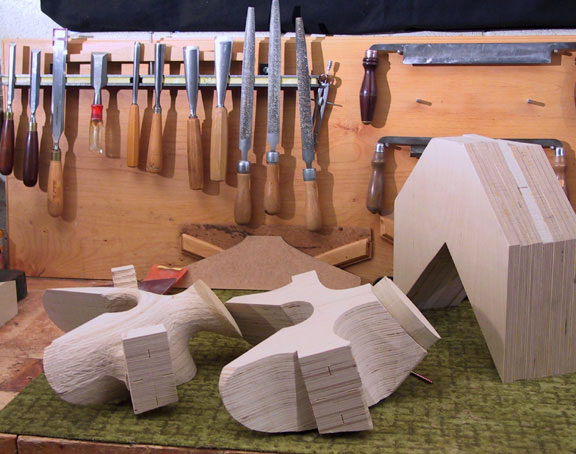Tools of the Trade: The Creak of Leather / Know How
Here is a glimpse of the process and some of the elements basic to making a custom saddle.
The Tree
Saddlers say the SADDLE TREE is the most important part of a saddle. It is the rawhide covered wooden form over which the saddle is built and determines the saddle's "look." Building a tree requires complex three-dimensional math skills with solid woodworking expertise. Three parts are essential to the tree: the bars, the cantle, and the swells or forks. The horn is either metal and attached or carved as an integral part of the forks. Opinion among makers regarding the best woods for building trees vary, but most prefer to use a straight-grained, knot-free, softwood with tight growth rings such as pine, spruce, or poplar. Its heavy rawhide covering, often obtained from a mature bull, provides the strength of the tree, especially in the critical horn area.
There are dozens of distinct tree styles and variations within them. Most saddlers purchase their trees from independent manufacturers, although a few build their own. The number of production tree companies has declined in past years, but custom shops have proliferated.
The Hide
It takes at least two sides of processed leather cowhide, preferably matched left and right, to build a saddle. The saddle parts are taken from various sections of the hide; some parts require thick, heavy leather, and others thinner sections. Saddlers order their oak tanned leather from large tanneries.
Design Transfer
TAP-OFFS are leather templates (flowers, leaves, etc.) used to transfer patterns to a piece of damp leather prior to carving and stamping. Saddlers make their own tap-offs, and each is as unique as a fingerprint. The dried leather tap-off is placed on the moist leather, design down, and tapped lightly with a mallet. After transferring the flowers and leaves, the carver uses a swivel knife to cut around the patterns and outline vines and stems surrounding the flower. Some saddlers prefer to draw an entire design onto a piece of drafting mylar, then trace the design from this to the leather. This practice produces designs that can be repeated many times. Only when the design is big and bold does a leather carver work freehand, without the aid of transfers or tap-offs.
Making a PAPER RUBBING is a common method of transferring a stamp pattern from leather to paper. Rubbings are useful for archiving designs for future use, or "borrowing" someone else's patterns.
Copper Rose Pattern, Drawing by Harwood
Stamping
The practice of leather stamping transfers artistic designs from the maker's imagination to a blank slate of leather.
Floral designs are the most common and popular style of stamping among saddlers. An infinite variety of floral patterns are possible, replete with vines, stems, leaves, acorns, and other fillers. Floral patterns are stamped with an assortment of tools, each providing a particular result that, when seen together, produce the complete image. (Read on for an in-depth look about Flower Stamping).
Set Stamps, such as those that produce block patterns, geometric designs, or a basket weave look, are made by repeating the same set impression, one after the other, and stacking them one atop the other. Set stamps allow a large area to be covered relatively quickly.
Figure Carving - such as images of people, animals, and scenery - is the least common style of stamping done by saddlers.
The stamping process is tedious and time-consuming work and the saddler has a whole set of tools for that specific purpose. Leather to be stamped must be damp, but not too wet; when just moist enough it is "in case." The stamper must work quickly and finish stamping while the leather is moist.
Photo by Jeremiah Watt
Photo by Adam Jahiel
The Art of Flower Stamping
The fraternity of flower stampers continues a tradition that was centuries old when the Spanish colonists introduced the craft to the New World. The art of flower stamping became regionally stylized wherever saddlemaking flourished. Until recently, the trades of saddlemaking and stamping were distinctly separate, and established saddleries employed stampers to decorate the work of their saddlemakers. With the decline of large firms and the proliferation of one and two-person saddle shops, it became necessary for today's saddlemakers to be competent flower stampers as well.
Some points to consider in viewing or judging stamped work are:
Smooth, graceful layout of elements
Even distribution of background area
Skilled use of tools in executing the design
Consistency of depth in cutting and stamping
Burnished tool impressions indicating proper moisture content of leather
Suitability as saddle decoration
Originality in both design and execution.
A Saddler’s Tools
The making and modification of stamping tools was once common among leather stampers. Homemade tools gave each stamper's work a unique look, and allowed them to earn a living as a contract stamp hand in the big saddle shops. Today, buying commercially made tools, or those made by toolmaking specialists, is more common. Many saddlemakers spend a lifetime collecting exceptional tools.
Some tools required to build saddles have not been commercially manufactured since the mid-1930s and are difficult to find. The old tools show classic lines and often incorporate the best tool steel, beautiful hardwood handles, and brass ferrules.
Most of the thirty or more types of tools needed to make a saddle come in different sizes, so the number of tools on a saddlemaker's bench can be staggering. Most bench tools are cutting tools of one form or another: cutters, skivers, trimmers, edgers, or splitters. Some tools, such as stitch markers, leave marks on the leather to guide work, while others gouge recessed grooves in which to sew.
Selected photos by Meg Glaser.













